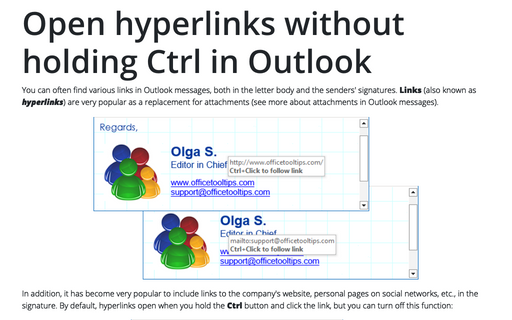Settings in Outlook 2016
Work with delivery and read requests in Outlook
Time to time, when you send an email, you need to be sure that this email has been delivered to the
recipient. In Outlook, you can ask for two different receipts: a delivery receipt and a read receipt.
Open hyperlinks without holding Ctrl in Outlook
By default, hyperlinks are opened by clicking with pressing or holding Ctrl, but you can
turn off this function.
Five tricks to customize your mailbox view
These five simple customizations of Microsoft Office Outlook mailbox view will save you a lot of time and
improve the overall productivity.
How to customize your Outlook messages
E-mail communications is not plain text anymore and people want to send/receive well-designed email
messages. There are many paid services that allow you to create a visually appealing e-mail template, but
you can create it yourself using only Outlook.
How to change the Mail Count Display
Outlook can display either the number of unread emails or the total number of emails in a folder alongside
the folder name.
How to change the default Address Book
This option controls which address book you see when you open the Address Book (via clicking
Ctrl+Shift+B) and when you click the To, Cc, or Bcc buttons when composing
e-mails.
How to add custom holidays to the calendar
This tip shows how to create and add custom holidays, for example, of your company to the Outlook calendar.
How to add country holidays to the calendar
This tip shows how to add holidays of your country or any other country to the Outlook calendar. See other
tip how to add custom holidays
to the calendar.
How to open replies and forwards in a new window
By default, if Reading pane is opened, Outlook opens replies and forwards in the same window, but you
can fix this behavior and open them in a new window.
Working with Data files in Outlook
Although Outlook automatically creates Data Files as needed when you add accounts, you might want to
add your own Data Files (.pst - files) to a profile. For example, perhaps you use an
Exchange Server account for your primary Outlook store, but want a set of personal folders to serve as an
archive; or perhaps you have an Exchange Server account and are adding a POP3 account.









